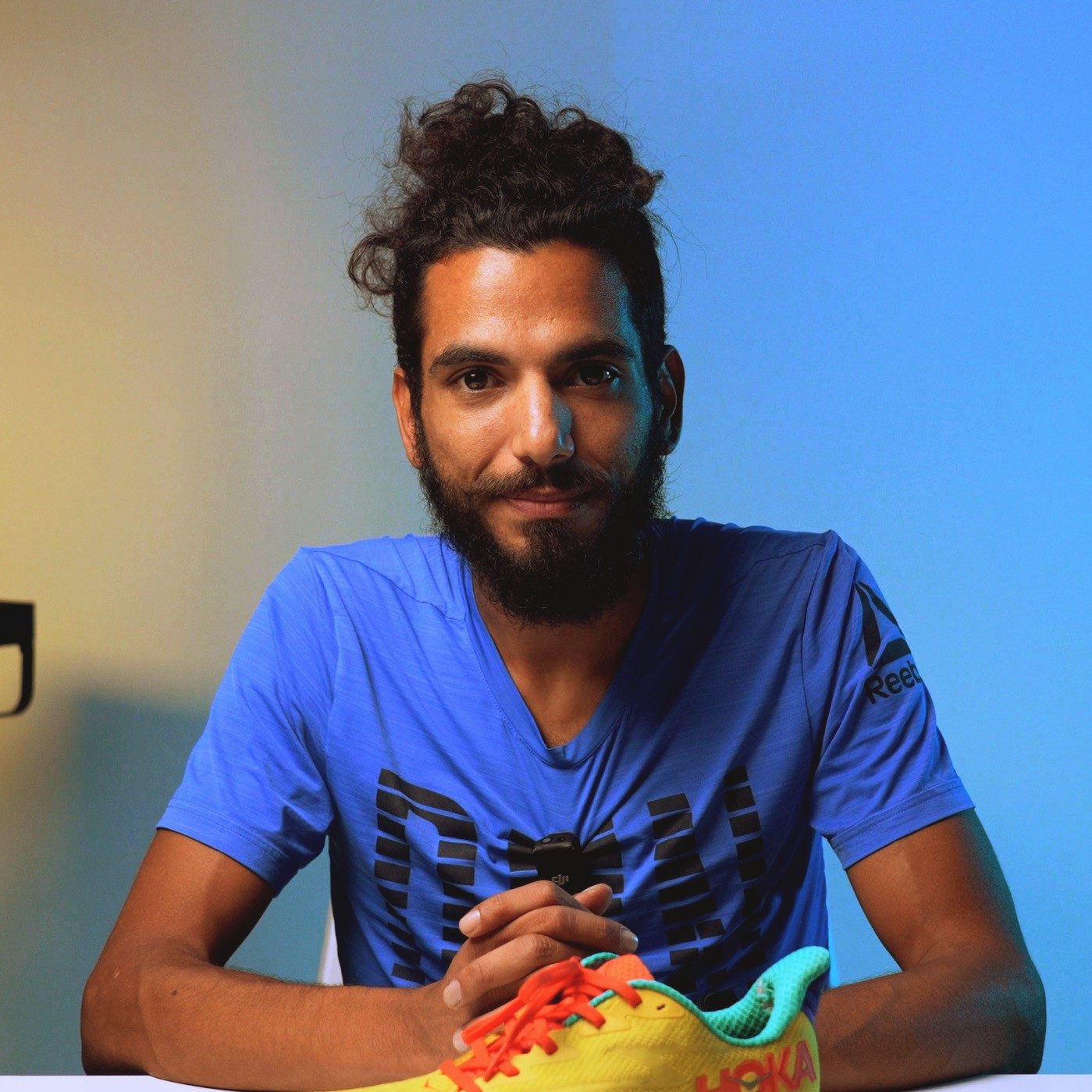Our verdict
Pros
- Budget friendly
- Flexible and comfortable underfoot
- Generously padded upper
- Extremely breathable
- Broad and stable base
- Versatile enough to tackle various activities
- Stylish and eco-friendly design
- Stylish and eco-friendly design
Cons
- Too heavy for long distances or speedwork
- Not for forefoot strikers
- Lacklustre outsole grip
- Heel hold could be better
Audience verdict
Comparison
The most similar running shoes compared
+ + Add a shoe | |||||
|---|---|---|---|---|---|
| Audience score | 82 Good! | 81 Good! | 81 Good! | 84 Good! | |
| Price | £80 | £90 | £80 | £70 | |
| Pace | Daily running | Daily running | Daily running | Daily running | |
| Shock absorption | Low | - | Low | - | |
| Energy return | Low | - | Low | - | |
| Traction | Low | - | Moderate | - | |
| Arch support | Neutral | Neutral | Neutral | Neutral | |
| Weight lab Weight brand | 11.5 oz / 326g 12.1 oz / 343g | 9.7 oz / 274g 10 oz / 283g | 10.5 oz / 298g 9.9 oz / 280g | 11.2 oz / 318g 10.1 oz / 285g | |
| Drop lab Drop brand | 11.3 mm 9.0 mm | 12.5 mm 9.0 mm | 9.4 mm 10.0 mm | 12.9 mm 8.0 mm | |
| Strike pattern | Heel | Heel | HeelMid/forefoot | Heel | |
| Size | True to size | True to size | Slightly small | True to size | |
| Midsole softness | Balanced | Balanced | Firm | Balanced | |
| Difference in midsole softness in cold | Normal | Small | Small | Normal | |
| Toebox durability | Decent | Good | Bad | Bad | |
| Heel padding durability | Decent | Good | Bad | Bad | |
| Outsole durability | Decent | Bad | - | Decent | |
| Breathability | Breathable | Breathable | Moderate | Moderate | |
| Width / fit | Medium | Medium | Medium | Medium | |
| Toebox width | Medium | Medium | Medium | Medium | |
| Stiffness | Moderate | Stiff | Moderate | Moderate | |
| Torsional rigidity | Moderate | Moderate | Moderate | Moderate | |
| Heel counter stiffness | Flexible | Moderate | Moderate | Flexible | |
| Heel lab Heel brand | 30.3 mm 25.0 mm | 30.7 mm 25.0 mm | 32.0 mm | 31.9 mm 34.0 mm | |
| Forefoot lab Forefoot brand | 19.0 mm 16.0 mm | 18.2 mm 16.0 mm | 22.6 mm | 19.0 mm 26.0 mm | |
| Widths available | NormalWide | Normal | NormalWideX-Wide | NormalWide | |
| Orthotic friendly | ✓ | ✓ | ✓ | ✓ | |
| Season | SummerAll seasons | SummerAll seasons | All seasons | All seasons | |
| Removable insole | ✓ | ✓ | ✓ | ✓ | |
| Ranking | #286 Bottom 23% | #294 Bottom 21% | #292 Bottom 22% | #241 Bottom 35% | |
| Popularity | #181 Top 49% | #324 Bottom 13% | #106 Top 29% | #319 Bottom 14% |
Who should buy
We recommend the Adidas Ultrabounce to anyone in the market for
- A shoe that’s comfy, versatile, and stylish enough to handle easy/moderate runs, gym days, or walks around town
- A budget-friendly, cushioned road shoe to add to their rotation
- A breathable daily trainer that’s suitable for runs in warm weather
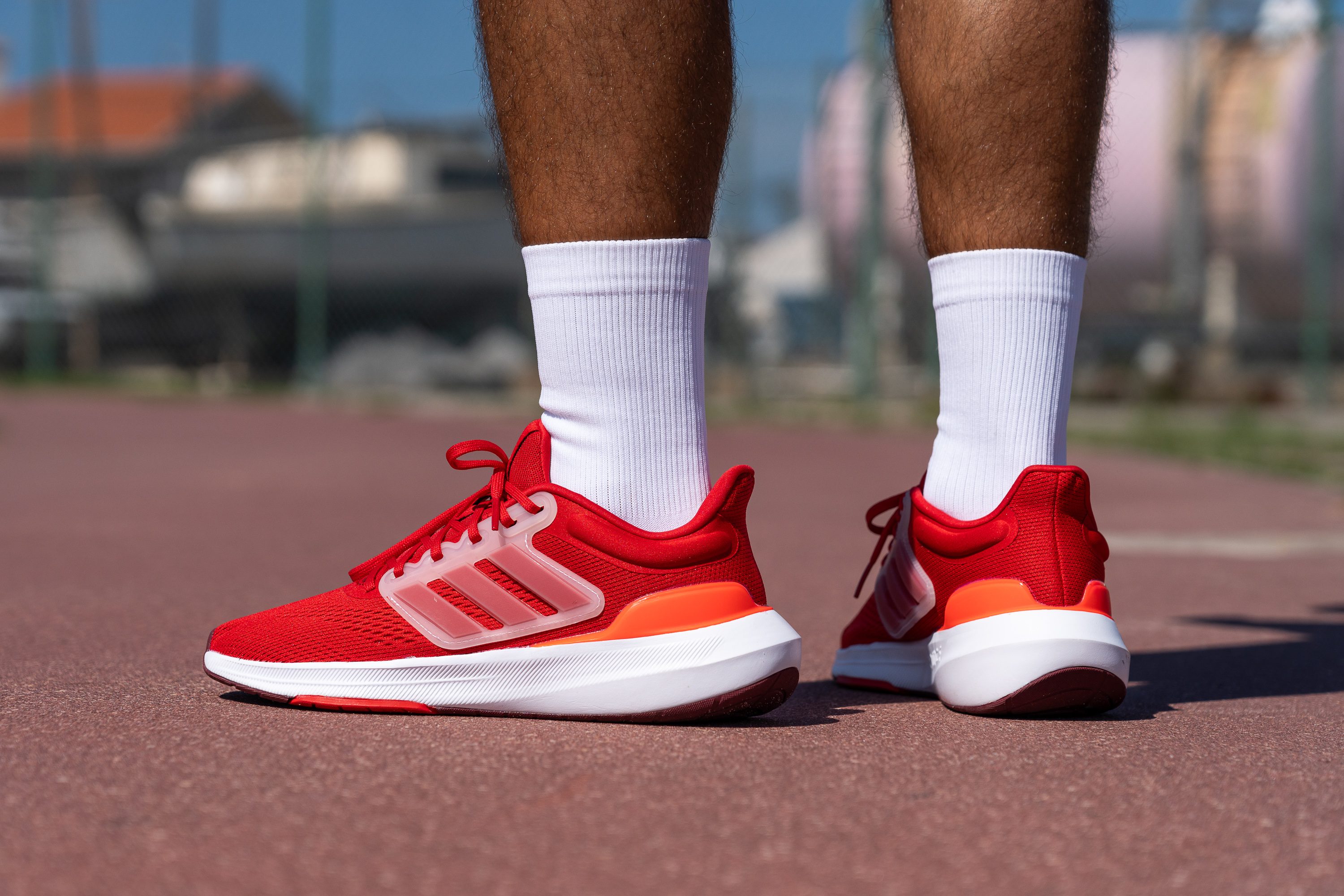
Who should NOT buy
While the shoe doesn’t feel that heavy at first, its certainly a chunky monkey that will feel like a burden when attempting speedwork. For a shoe that’s much more lightweight and capable of high-paced sessions, we recommend having a look at the similarly wallet-friendly Brooks Revel 6.
With a much lower than average stack at the forefoot, the Ultrabounce won’t feel as protective over long distances for runners with a forefoot striking stride. For a shoe with more protective foam at the forefoot, we suggest checking out the Adidas Adizero SL instead.
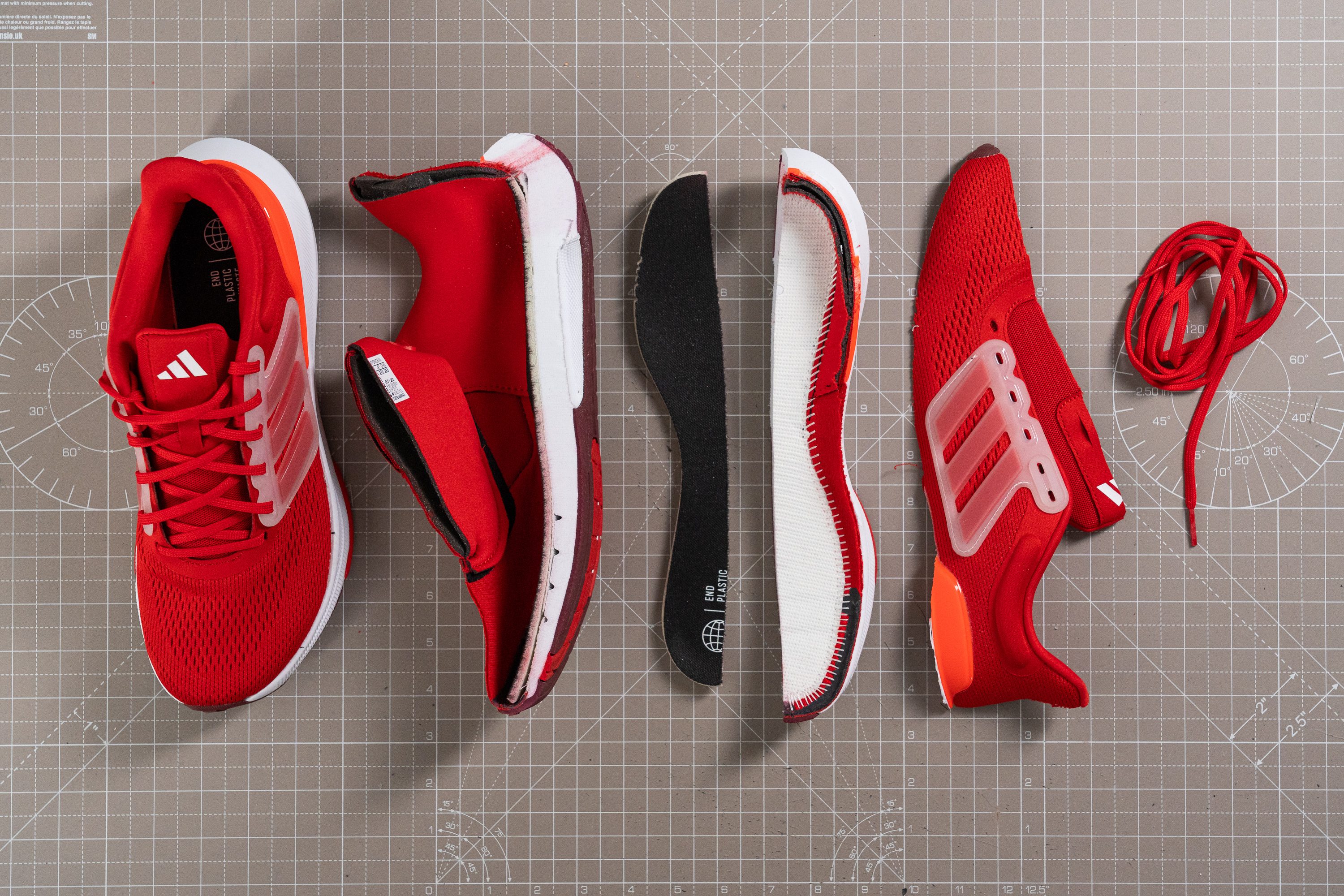
The Bounce midsole foam provides good enough cushions for easy to moderate runs, however pushing the limits and going for long haul efforts exposes the midsole’s weakness. For a shoe that boasts better cushioning for long miles, we suggest the similarly priced Brooks Launch 10 or the more expensive, plated yet plush Hoka Mach X.
Cushioning
We also repeated our flexibility test after leaving the Ultrabounce in the freezer for twenty minutes, with a result of 32.2N now needed to bend the shoe to the same point. While definitely a rather stiff result, it isn’t nearly as rigid as the average road shoe becomes under similar conditions.
Similar to the midsole performance, the Ultrabounce displays a distinct lack of consistency in its flexibility. With a 57.8% increase in the shoe’s stiffness, it doesn’t perform nearly as well as the average shoe between warm and cold conditions. Therefore, we don't recommend this shoe to those living in places with long and harsh winters. For those runners, we suggest checking out the Brooks Levitate Stealthfit 6 which is much more conducive to frigid runs.
Shock absorption
The Ultrabounce delivers just 104 SA of shock absorption in the heel and an ultra-low 66 SA in the forefoot. With these numbers, it’s clear this shoe won’t provide top-tier joint protection. Quite the opposite, in fact.

| Ultrabounce | 104 SA |
| Average | 129 SA |
Energy return
We also found energy return to be underwhelming, topping out at just 51.5%. It’s not the kind of result we like to see—but given the budget-friendly price, it’s not exactly unexpected either.
| Ultrabounce | 51.5% |
| Average | 58.5% |
Heel stack
We measured the Ultrabounce’s heel stack to be 30.3 mm thick at the heel. While this is a little lower than our current lab average, the shoe will still provide a great level of cushioning for heel striking runners.
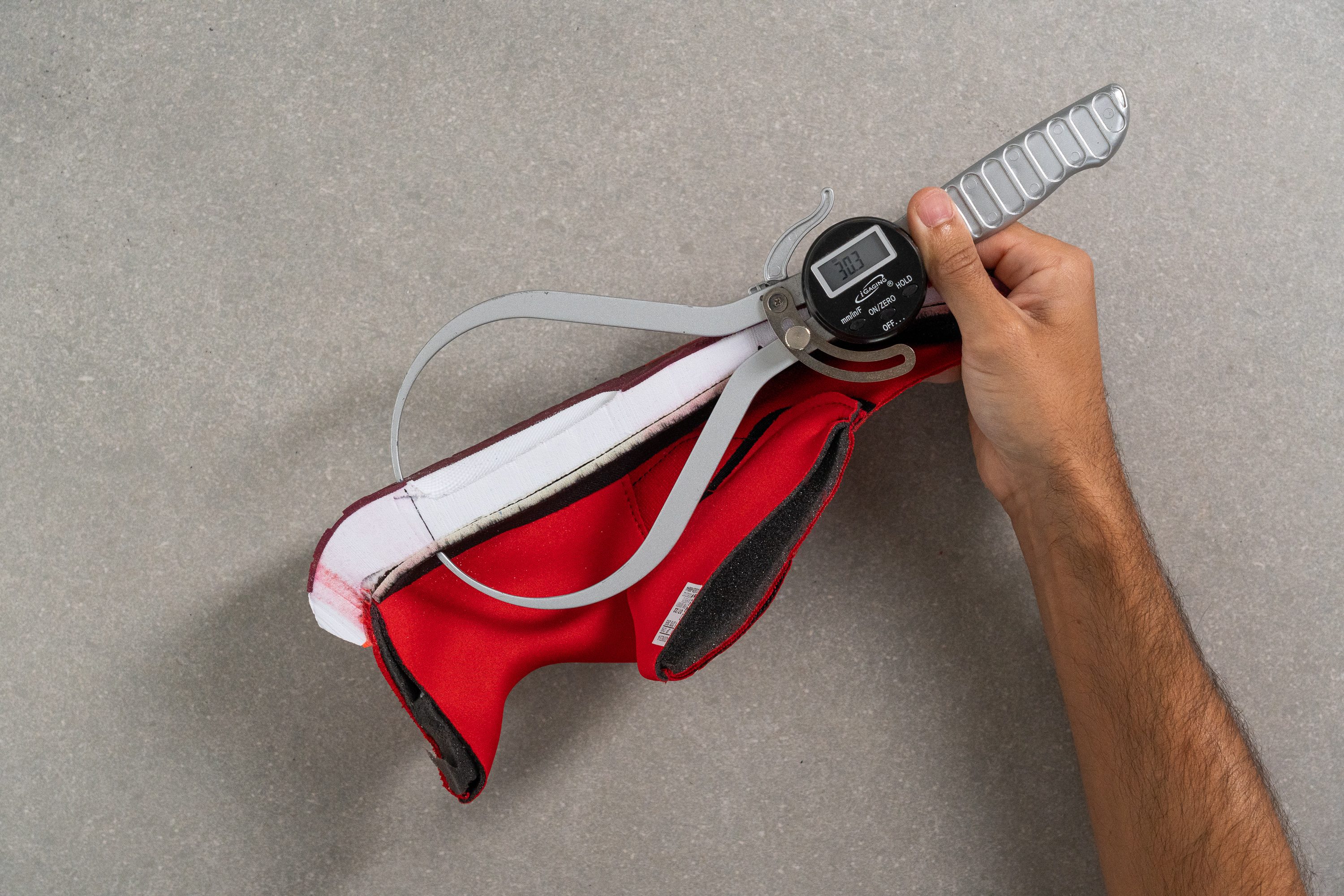
| Ultrabounce | 30.3 mm |
| Average | 34.8 mm |
Forefoot stack
Moving up to the forefoot, the Ultrabounce has only a scant 19 mm of foam underfoot. This below average stack means that forefoot strikers won’t enjoy nearly the same amount of cushioning as their heel striking counterparts.

For a shoe that’s more generously padded at the forefoot, we recommend Adidas’ more wallet-friendly (but still more expensive) version of their premium line, the Adizero SL.
| Ultrabounce | 19.0 mm |
| Average | 26.2 mm |
Drop
The difference in our stack measurements leaves the shoe with a drop height of 11.3 mm. This put the Ultrabounce in the category of high-drop shoes which, in combination with the short forefoot stack, makes the shoe more favourable to heel striking runners.
Forefoot striking runners will be much better served with a mid-drop shoe like the Mizuno Waverider 26.
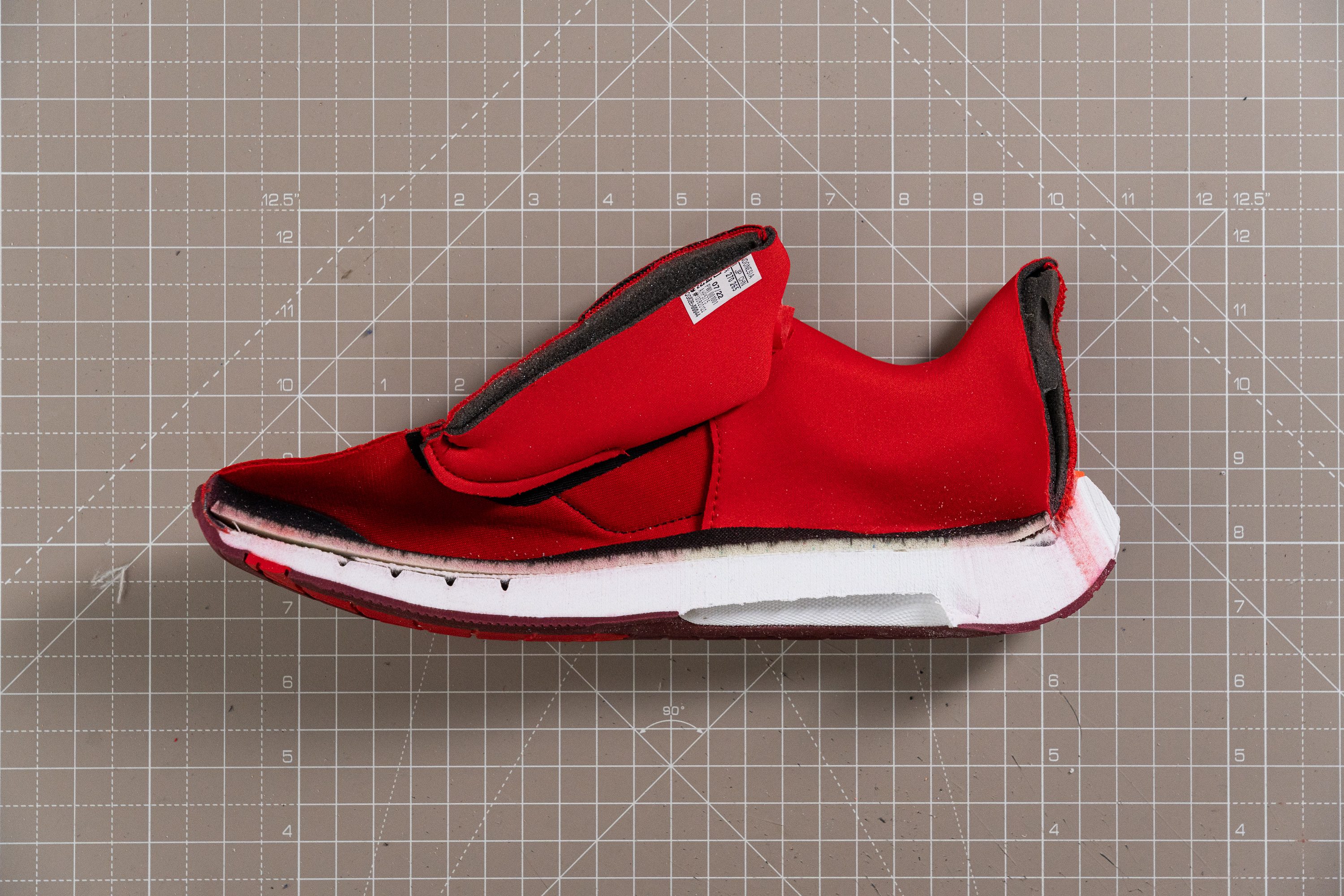
| Ultrabounce | 11.3 mm |
| Average | 8.6 mm |
Midsole softness
To test the softness of the shoe’s Bounce foam, we pressed our durometer against the Ultrabounce’s midsole and got a reading of 24.8 HA. This level of softness fall right within the average range, and provides an adequate level of balanced cushioning that feels protective enough for most easy to moderate runs.
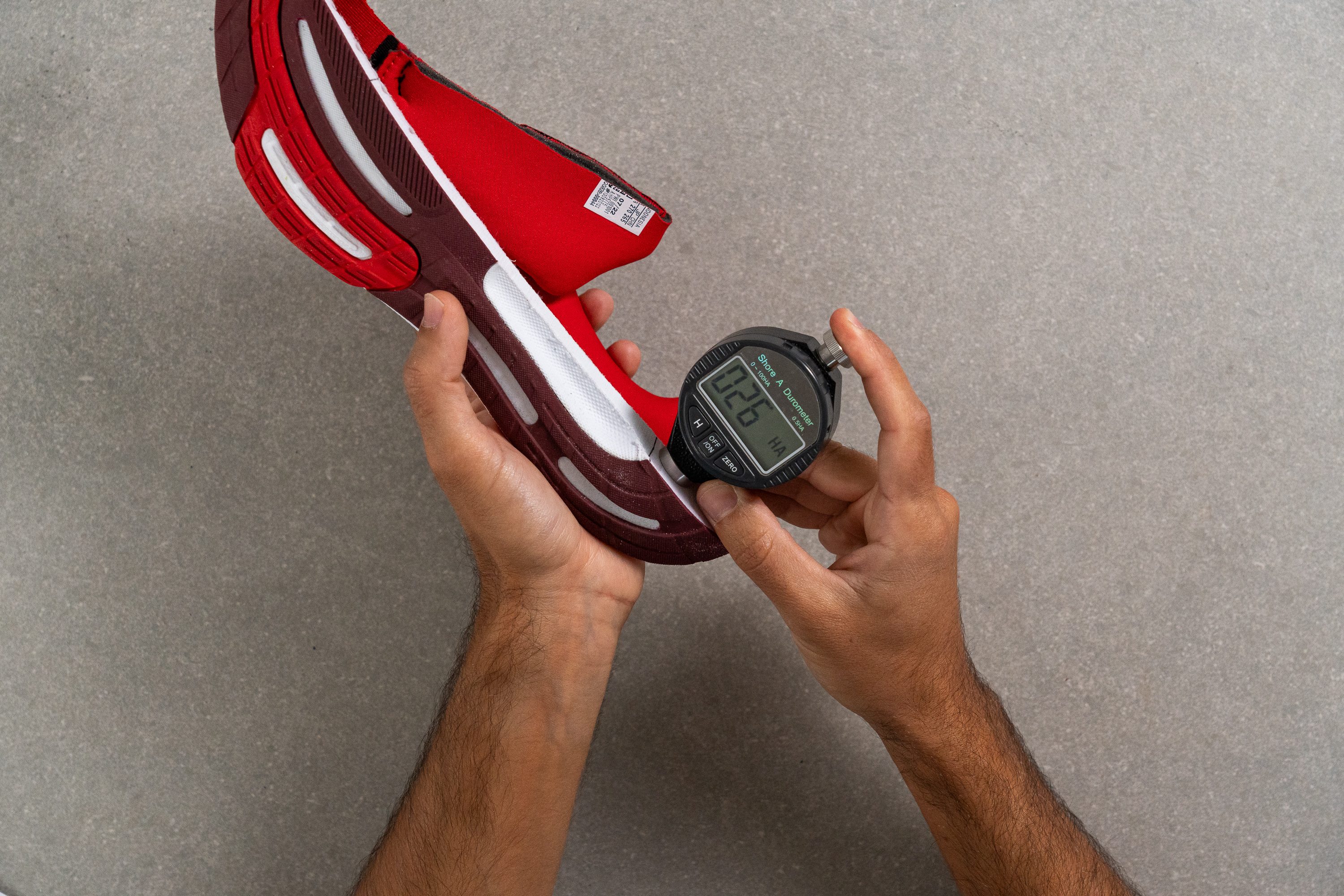
In its heyday, the Bounce midsole foam utilised in this shoe was considered to be top-of-the-line as it offers good cushions and a decent level of energy return. These days, however, its ride feels a little more antiquated, especially with more advanced and responsive midsoles out on the market; including the softer yet more energetic Boost foam by Adidas that can be found on shoes like the Ultraboost Light.
| Ultrabounce | 24.8 HA |
| Average | 20.4 HA |
Size and fit
Size
Adidas Ultrabounce fits true to size (32 votes).
Width / Fit
Using our calliper, we measured the Ultrabounce to be 96.2 mm at its widest point, which is right on par with our current lab average.
This measurement, in combination with the shoe’s soft and forgiving upper mesh, means that the Ultrabounce should be able to accommodate most foot shapes except for those with very broad feet.
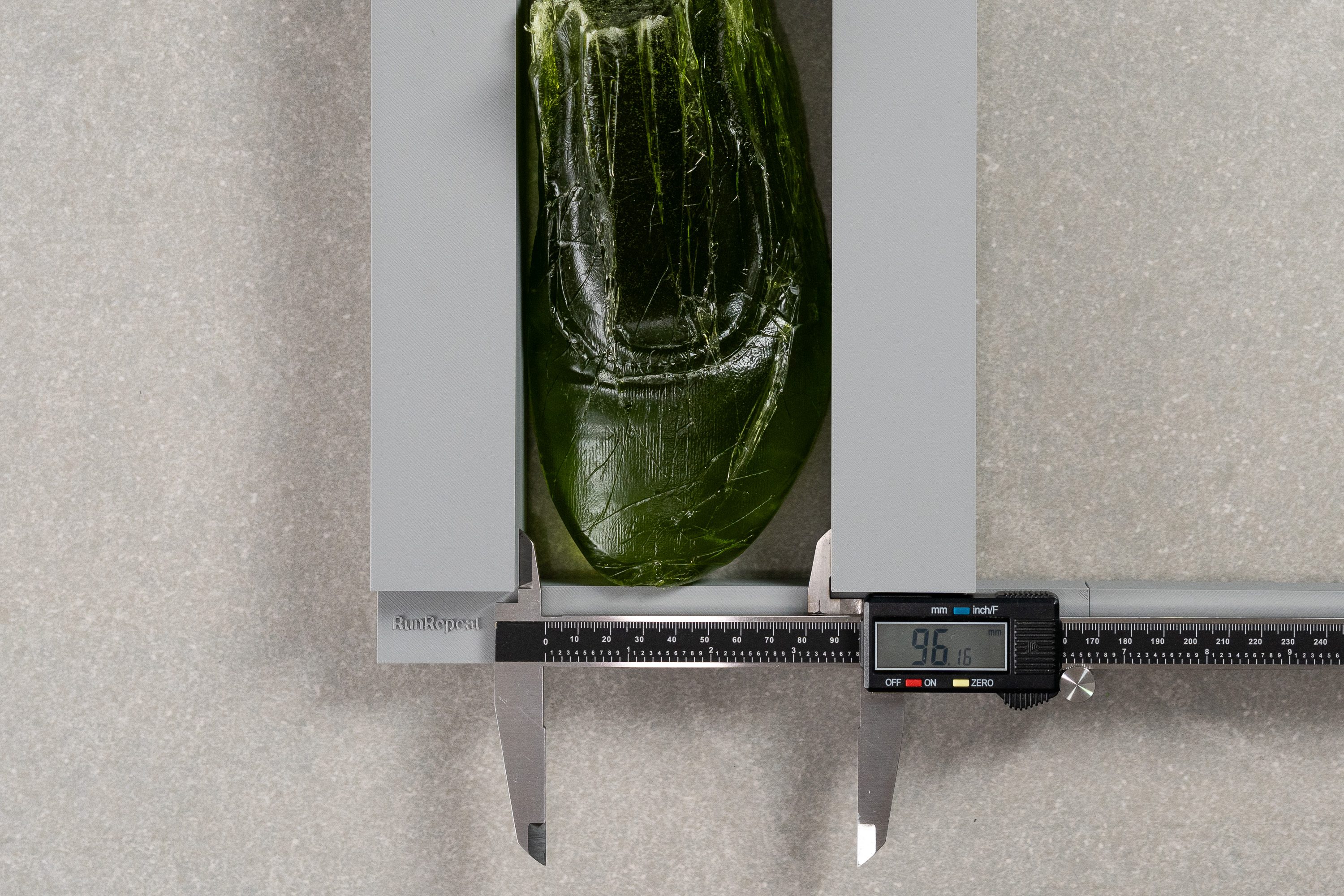
| Ultrabounce | 96.2 mm |
| Average | 95.1 mm |
Toebox width
Around the big toe area, we measured the Ultrabounce’s toebox at a slightly roomier-than-average 75.3 mm. Furthermore, during our testing, we experienced more toe space than in nearly any other Adidas daily trainer.
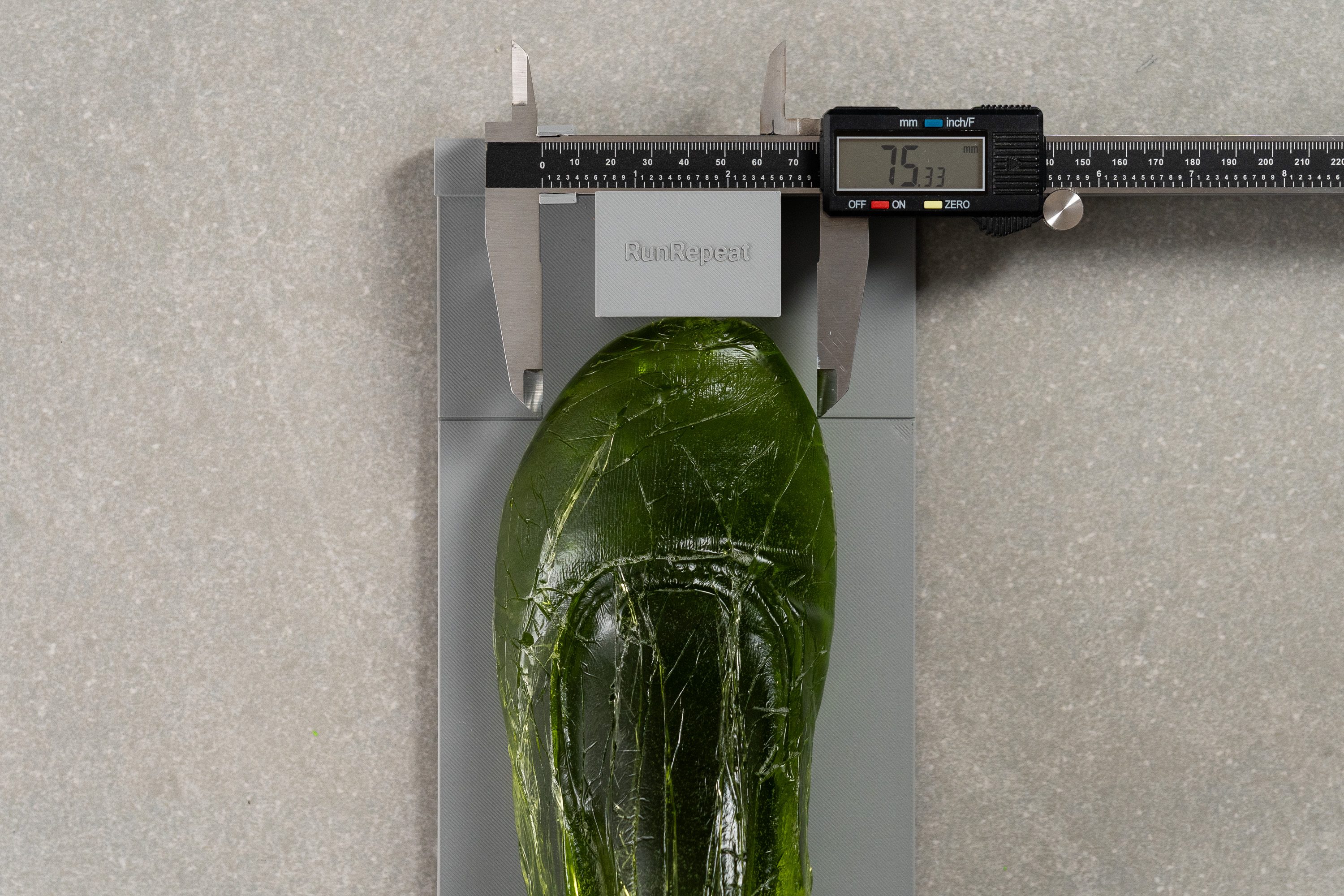
| Ultrabounce | 75.3 mm |
| Average | 73.2 mm |
Toebox height
We measured the toebox height at 27.1 mm, which we found sufficient due to the soft mesh upper.

| Ultrabounce | 27.1 mm |
| Average | 27.1 mm |
Traction / Grip
The Ultrabounce really is full of surprises. While our findings in the lab so far generally suggest that a harder outsole means more durability and less grippiness, this shoe proves to be an exception to that rule. The tread pattern and the almost full rubber coverage of the outsole meant that we experienced great traction in this shoe over a multitude of surfaces. Who would have thought?!

Traction test
The Ultrabounce tried to mimic the Ultraboost’s outsole pattern using lower-cost rubber—but that’s exactly where it went wrong. Grip comes mostly from the compound, not the design, and this one scored a dismal 0.18 in our test, making it one of the worst we’ve ever measured.
It can serve for some casual running in dry conditions, but forget about tackling wet roads with the Ultrabounce.
| Ultrabounce | 0.18 |
| Average | 0.48 |
Outsole design
The outsole of the Adidas Ultrabounce features partial rubber coverage strategically focused on high-impact areas. Two dense rubber pods cover the heel and forefoot, with a mix of horizontal and vertical grooves integrated for added segmentation and flexibility.

Flexibility / Stiffness
To measure how stiff or flexible the shoe is, we secured the Ultrabounce to our machine and measured the amount of force needed to bend the shoe to 30-degrees. With a result of 14.2N, the Ultrabounce is not very flexible, making it a bit stiff for casual use.
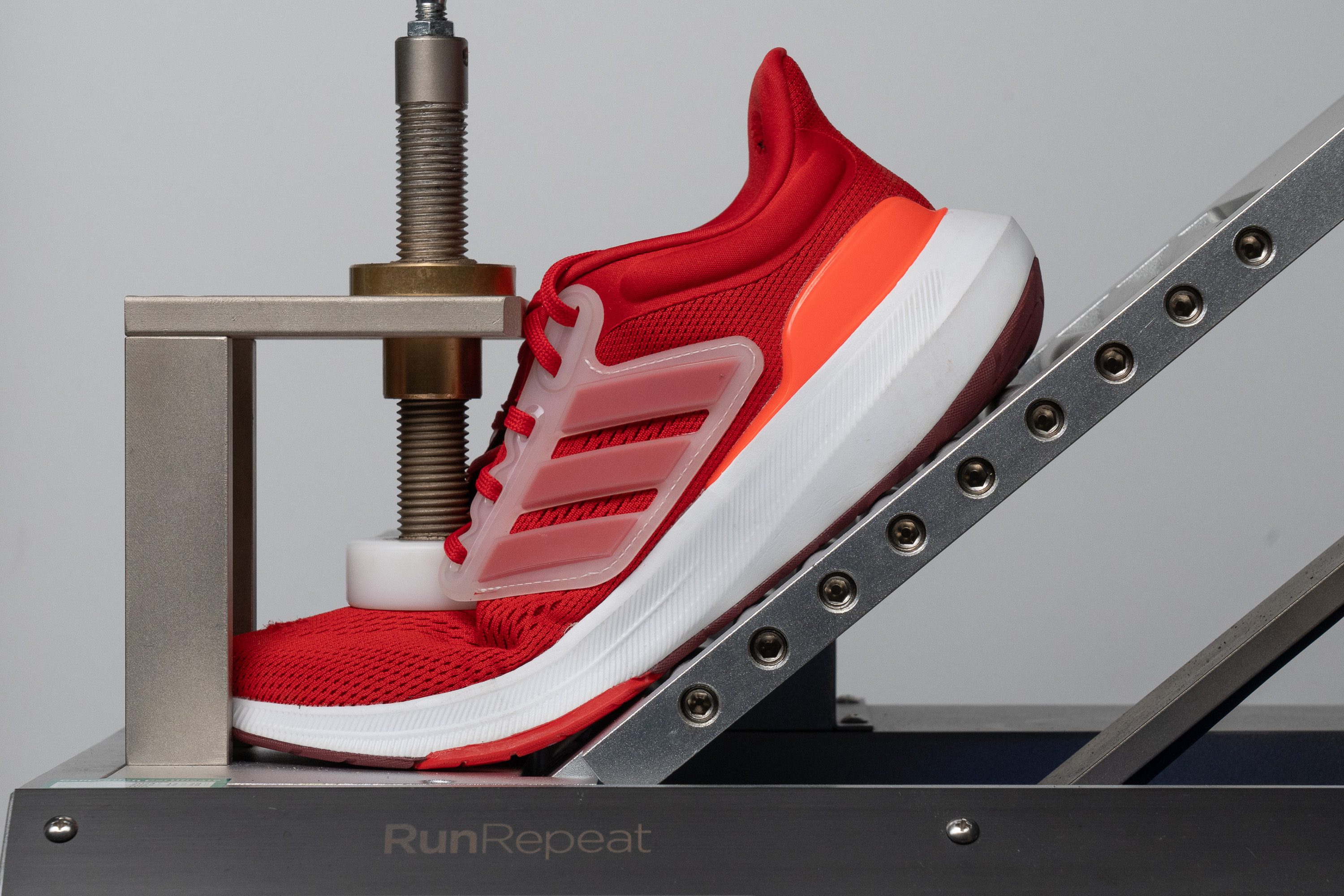
| Ultrabounce | 14.2N |
| Average | 15.3N |
Stiffness in cold (%)
We also repeated our flexibility test after leaving the Ultrabounce in the freezer for twenty minutes, with a result of 32.2N now needed to bend the shoe to the same point. While definitely a rather stiff result, it isn’t nearly as rigid as the average road shoe becomes under similar conditions.
Similar to the midsole performance, the Ultrabounce displays a distinct lack of consistency in its flexibility. With a 57.8% increase in the shoe’s stiffness, it doesn’t perform nearly as well as the average shoe between warm and cold conditions. Therefore, we don't recommend this shoe to those living in places with long and harsh winters. For those runners, we suggest checking out the Brooks Levitate Stealthfit 6 which is much more conducive to frigid runs.
| Ultrabounce | 58% |
| Average | 33% |
Weight
While the bounce part in Ultrabounce suggests some level of lightness, this couldn’t be further from the truth. Tipping the scale at a hefty 11.5 Oz (326g), the Ultrabounce is significantly heavier than the average road shoe. This makes it less than ideal for long distance days or tempo training.

| Ultrabounce | 11.5 oz (326g) |
| Average | 9.3 oz (264g) |
Breathability
We don’t usually expect the best breathability from budget friendly shoes, but the Ultrabounce gave us a pleasant surprise during our smoke test. As the video demonstrates, the smoke manages to escape almost as soon as it is pumped into the shoe. What’s more, the ventilation seems to be quite even throughout the shoe’s upper and tongue, leading us to give the shoe a perfect 5 out of 5 for breathability!
Inspecting a cross section of the shoe’s upper; we can see how well perforated the Ultrabounce’s upper is, which obviously promotes great airflow throughout the shoe.
Looking at the upper material through our microscope, it’s kind of surprising how well the shoe performed in our smoke test. The fibres that make up the upper are so tightly woven, with another more loosely braided layer underneath. Looking at this alone, we would have assumed that it’s a rather well insulated shoe, but that speaks to just how airy the fibres themselves are!

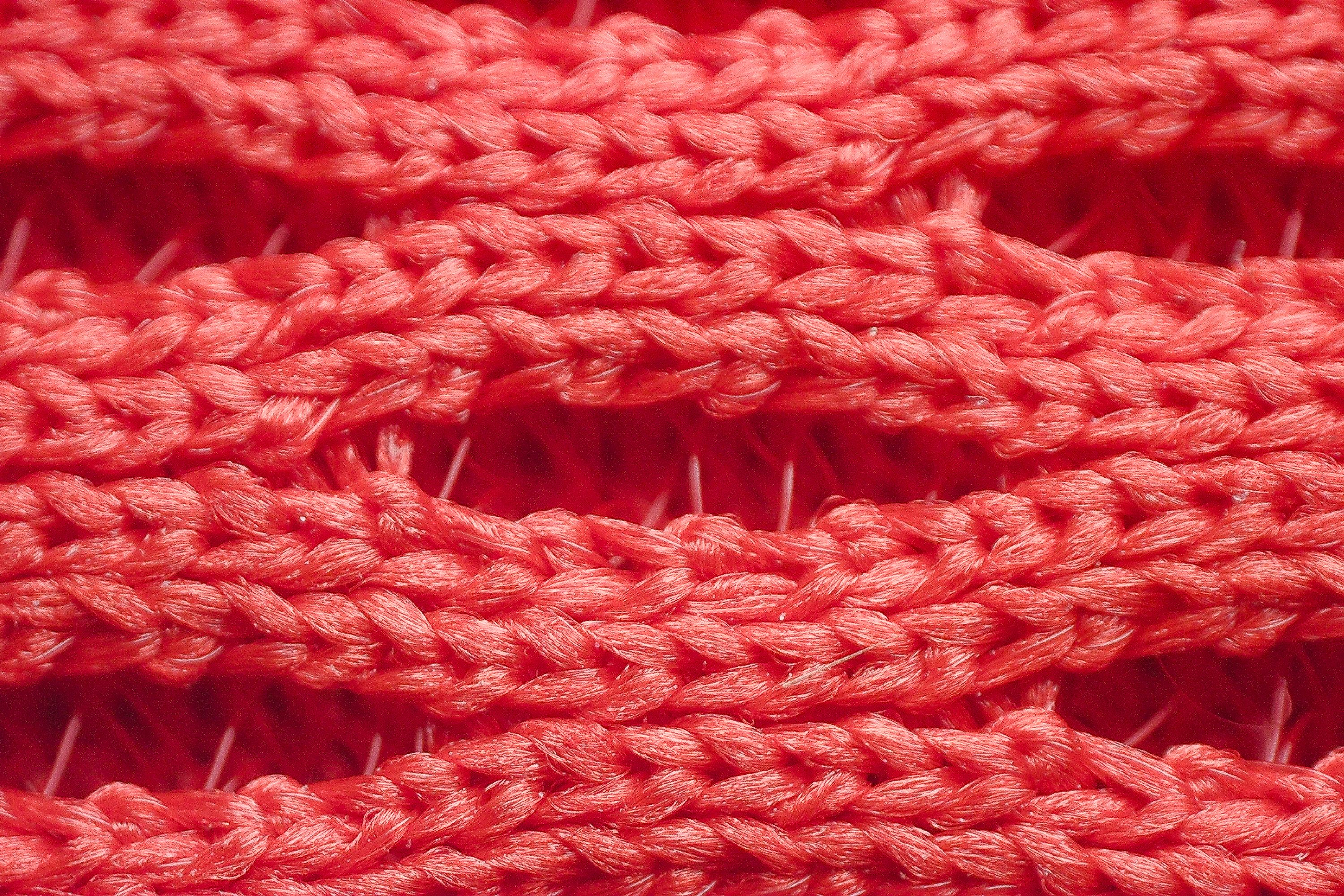
| Ultrabounce | 5 |
| Average | 3.7 |
Stability
Lateral stability test
Despite having no additional stability features, the Ultrabounce feels extremely well planted to the ground when we shifted our weight from side to side. We’ll be exploring how Adidas achieved this over the course of our next few stability tests.
Torsional rigidity
We bent and twisted the shoe in our hands to assess the shoe's torsional rigidity. With an about average level of resistance to our manipulations, we gave the shoe a score of 3 out of 5 on our subjective scale.
This moderate level of rigidity helps to prevent any excessive rolling of the foot, while still being flexible enough to allow our foot to bend and contort naturally during our stride. However, this isn’t enough support for pronating runners who will be better served with a shoe with added stability features like the ASICS 1000 12.
| Ultrabounce | 3 |
| Average | 3.5 |
Heel counter stiffness
The shoe’s heel counter didn’t put up so much resistance as we poked, squeezed and prodded at it, leading us to give the shoe a 2 out of 5 for heel counter stiffness.
This level of flexibility in the heel counter lends itself to comfort, especially for those with Achilles tendon issues. However, in combination with the shape of the Ultrabounce’s heel cup, we weren’t able to achieve as secure a rearfoot lockdown as we would like in this shoe and did feel some heel slippage during our test runs.
| Ultrabounce | 2 |
| Average | 2.9 |
Midsole width - forefoot
We measured the shoe’s midsole to be 114.4 mm wide at the forefoot which is ever-so slightly broader than our current lab average. This width of base had us feeling surefooted and confident during our runs, with smooth toe-offs that didn't feel blocky even when cornering.
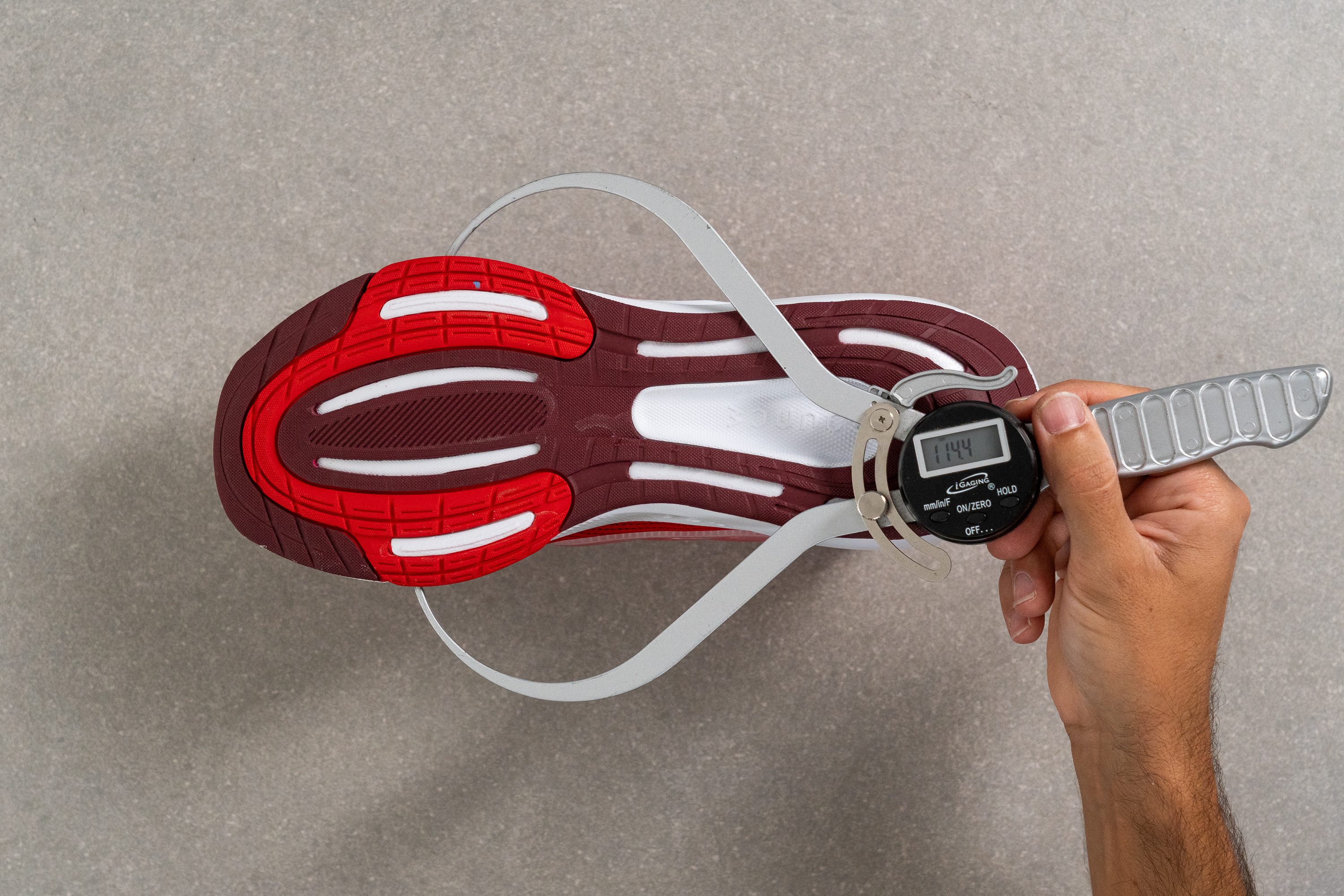
| Ultrabounce | 114.4 mm |
| Average | 114.4 mm |
Midsole width - heel
Measuring 92.2 mm wide, the Ultrabounce’s midsole is also just a hair wider than our current lab average at the heel. This ensures that heel striking runners have plenty of platform for surefooted landings.
| Ultrabounce | 92.2 mm |
| Average | 90.7 mm |
Durability
Toebox durability
Breathability and durability don’t often go hand in hand, so we didn’t have high hopes when we fired up our Dremel to test the durability of the toebox. Here we were also faced with a pleasant surprise. After contending with our tool’s grinding element for four seconds, we didn’t find as much damage as we had anticipated.
It still only merits a durability score of 2 out of 5, but that’s a better result than many shoes that have faced off against our dreaded Dremel.
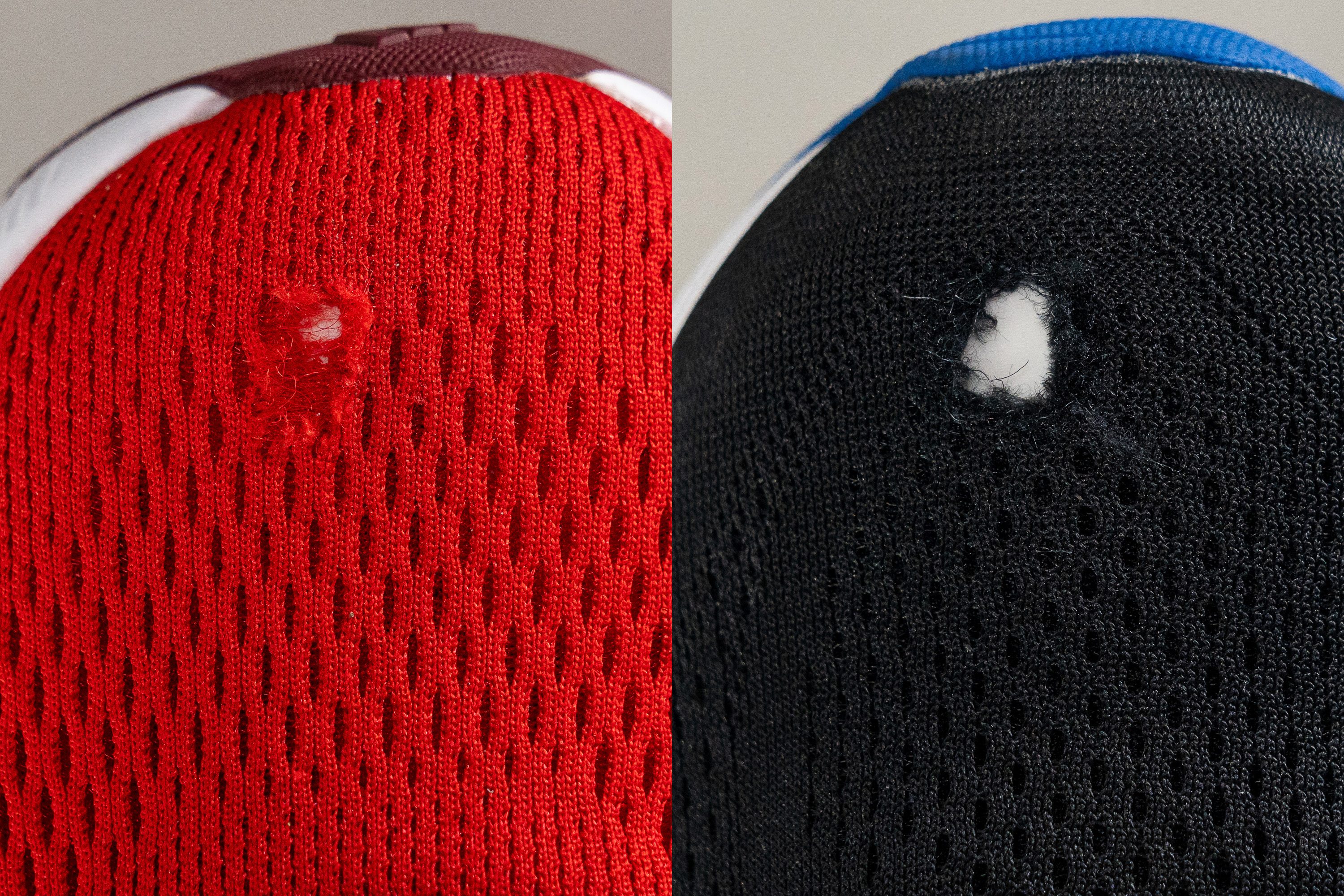
To see what a 1 out of 5 looks like; here's the damage side-by-side with the aftermath of running the much less durable ASICS GT 1000 12 through the same test.
| Ultrabounce | 2 |
| Average | 2.6 |
Heel padding durability
The heel padding also displayed better than expected durability when we subjected it to the same grinding force as the toebox. While we were able to pretty much tear through the lining, only a small amount of padding was lost.
As a result we give the Ultrabounce a heel padding durability score of 3 out of 5, which means that going sockless in this shoe won’t wear out the heel collar prematurely.

The New Balance FuelCell Rebel v3's heel padding didn't fare nearly as well in the same test, and gives us a good baseline for what a 1 out of 5 looks like.
| Ultrabounce | 3 |
| Average | 3.4 |
Outsole hardness
We pressed our durometer against the Ultrabounce’s outsole rubber and got a much higher than average result of 86.6 HC. This level of hardness bodes well for the upcoming durability test… or does it?

| Ultrabounce | 86.6 HC |
| Average | 79.2 HC |
Outsole durability
As opposed to our previous durability tests, we actually had high hopes for the outsole’s durability given the hardness reading from our previous test. Unfortunately this time it was an unpleasant surprise we faced once we had powered down our Dremel after the twenty second test.
Measuring the damage with a tyre tread gauge, we found that we had lopped off a whopping 1.16 mm of material from the outsole. This makes the Ultrabounce’s outsole less durable than that of the average road shoe, which goes to show that sometimes hard materials can also be brittle.
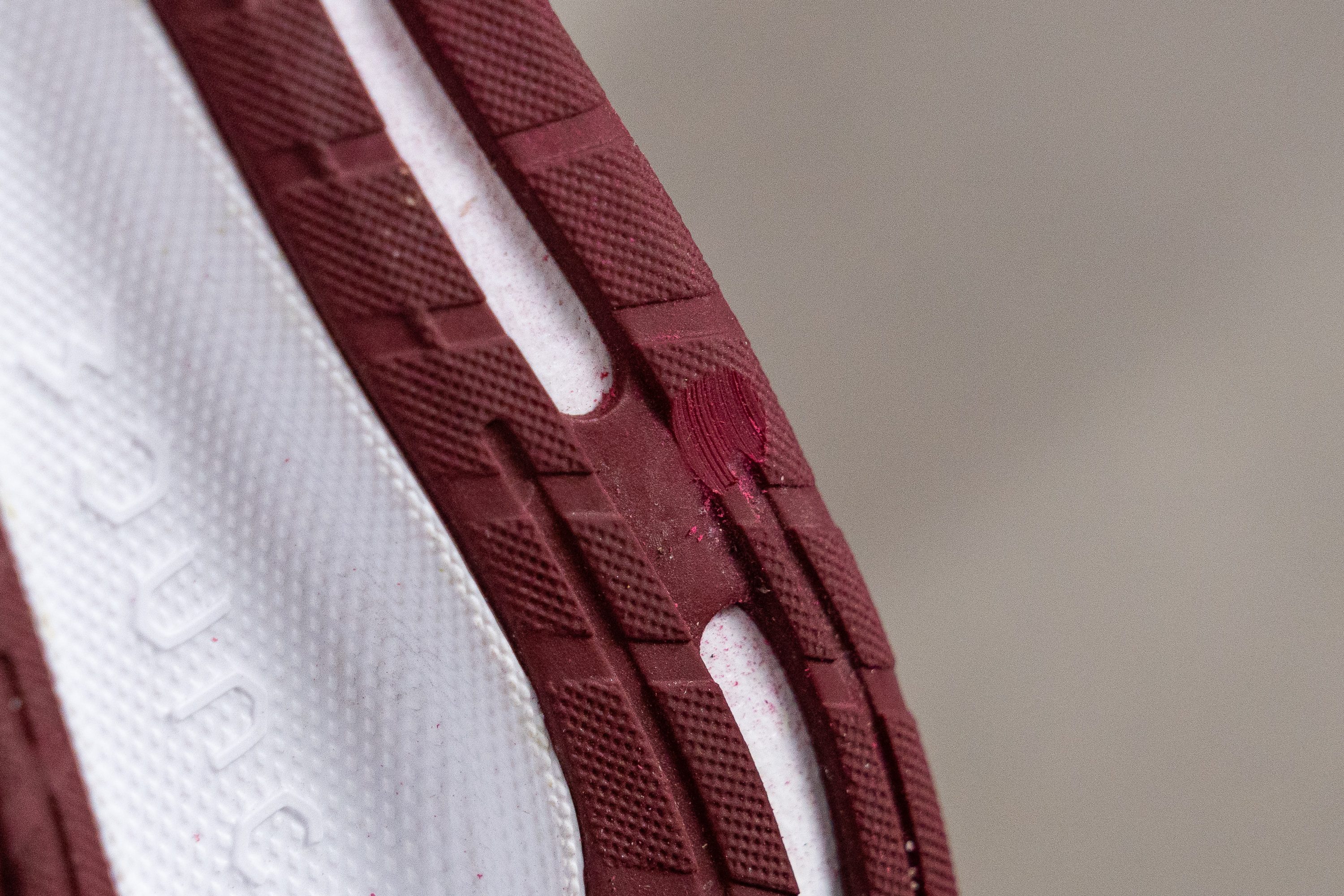
| Ultrabounce | 1.1 mm |
| Average | 1.1 mm |
Outsole thickness
Using our caliper, we measured the shoe;s outsole to be 3.1 mm thick. This is slightly less thick than our current lab average, which ordinarily wouldn’t be an issue; but the shoe’s performance in our previous test means that we expect to see significant signs of wear and tear by 400-miles of use.

| Ultrabounce | 3.2 mm |
| Average | 3.2 mm |
Misc
Insole thickness
We measured the shoe’s insole to be 3.7 mm thick. While this isn’t as padded as our current lab average, we still had a nice and soft landing surface within the shoe that nicely complemented the shoe’s midsole cushioning during our test runs.
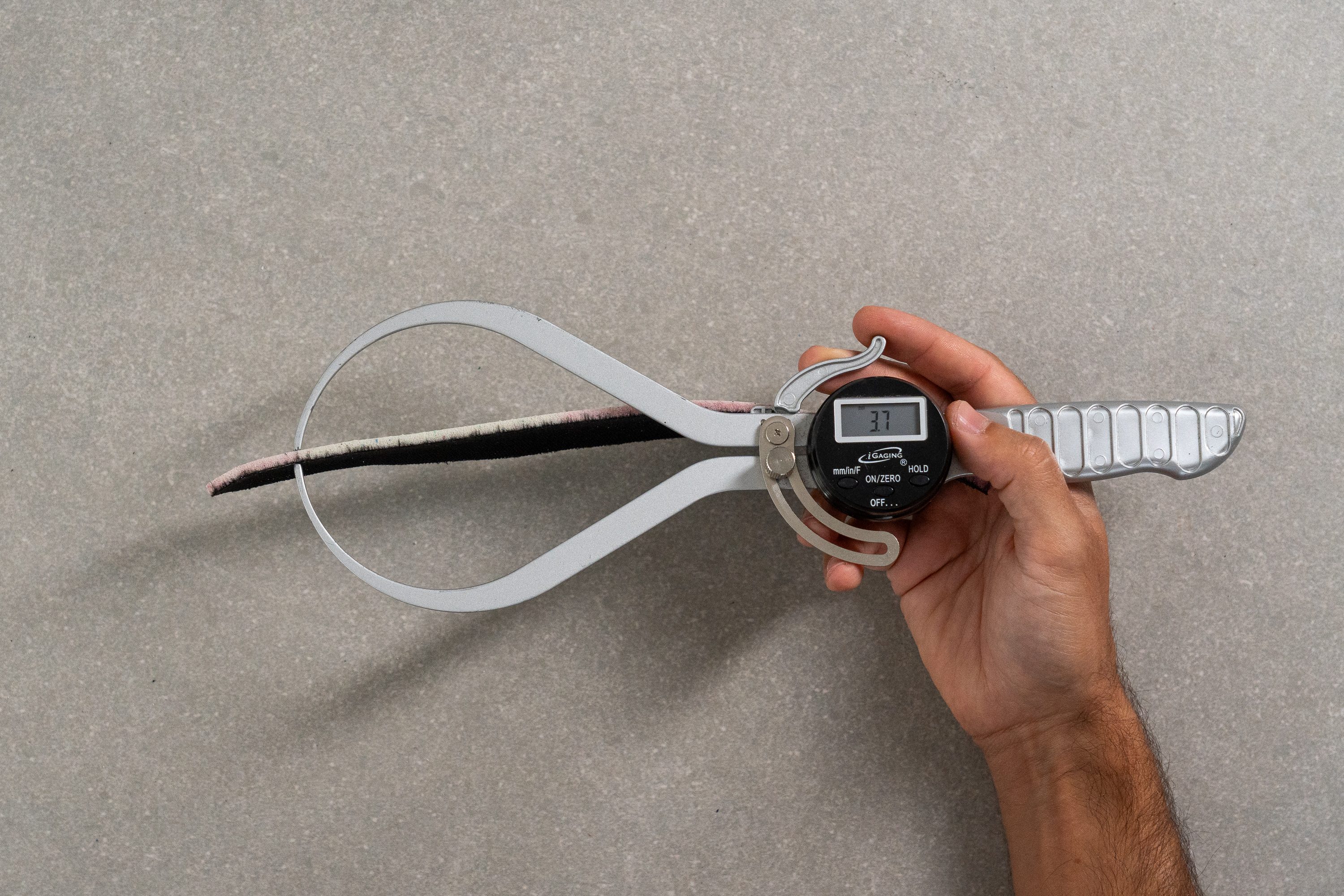
| Ultrabounce | 3.7 mm |
| Average | 4.5 mm |
Removable insole
The insole of the Ultrabounce isn’t glued in, and so can be removed in favor of custom orthotics where necessary.
| Ultrabounce | Yes |
Midsole softness in cold (%)
To see how the midsole is affected by cold weather, we let the Ultrabounce chill in the freezer for twenty minutes and took another durometer reading of the foam. With a post-freezer reading of 34.3 HA, the Ultrabounce’s midsole becomes 38.3% more firm in the cold.
As such, the Ultrabounce isn't as consistent as the average shoe under similar conditions, which means its already firm ride will feel a bit more solid come wintertime.

| Ultrabounce | 38% |
| Average | 24% |
Reflective elements
Who’s got two sets of laces and no reflective elements whatsoever? The Ultrabounce unfortunately; so we don’t recommend going out for nighttime runs with \out additional high-visibility gear.
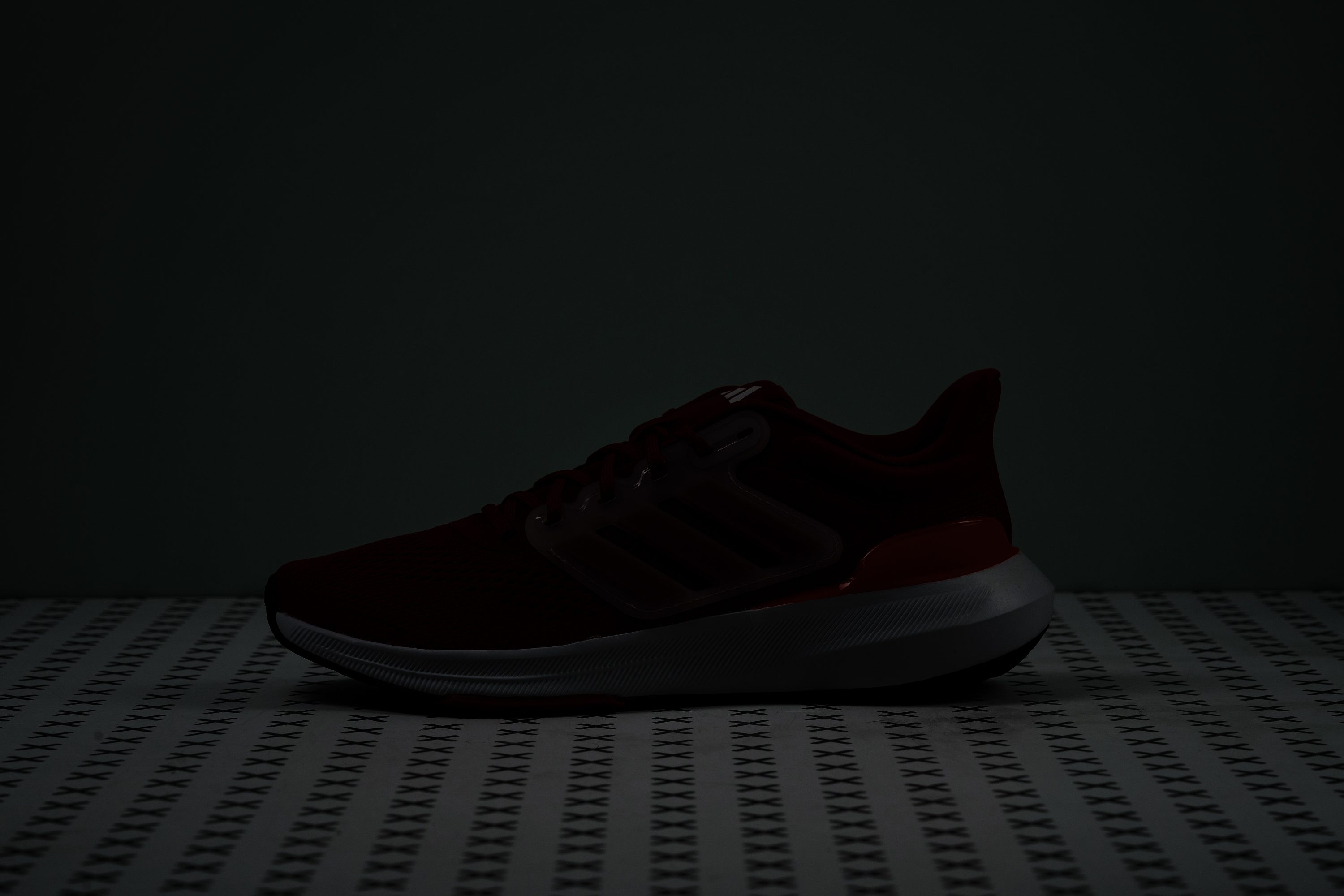
| Ultrabounce | No |
Tongue padding
The Ultrabounce sports a tongue that’s much more padded than the average road shoe, measuring 8.5 mm thick. In spite of this, however, the laces still feel surprisingly apparent around our instep once the shoe is laced up nice and tight. While this isn’t going to be an issue during easy runs, walks, or gym days; it definitely becomes more of a nuisance as our feet swell towards the end of longer runs.
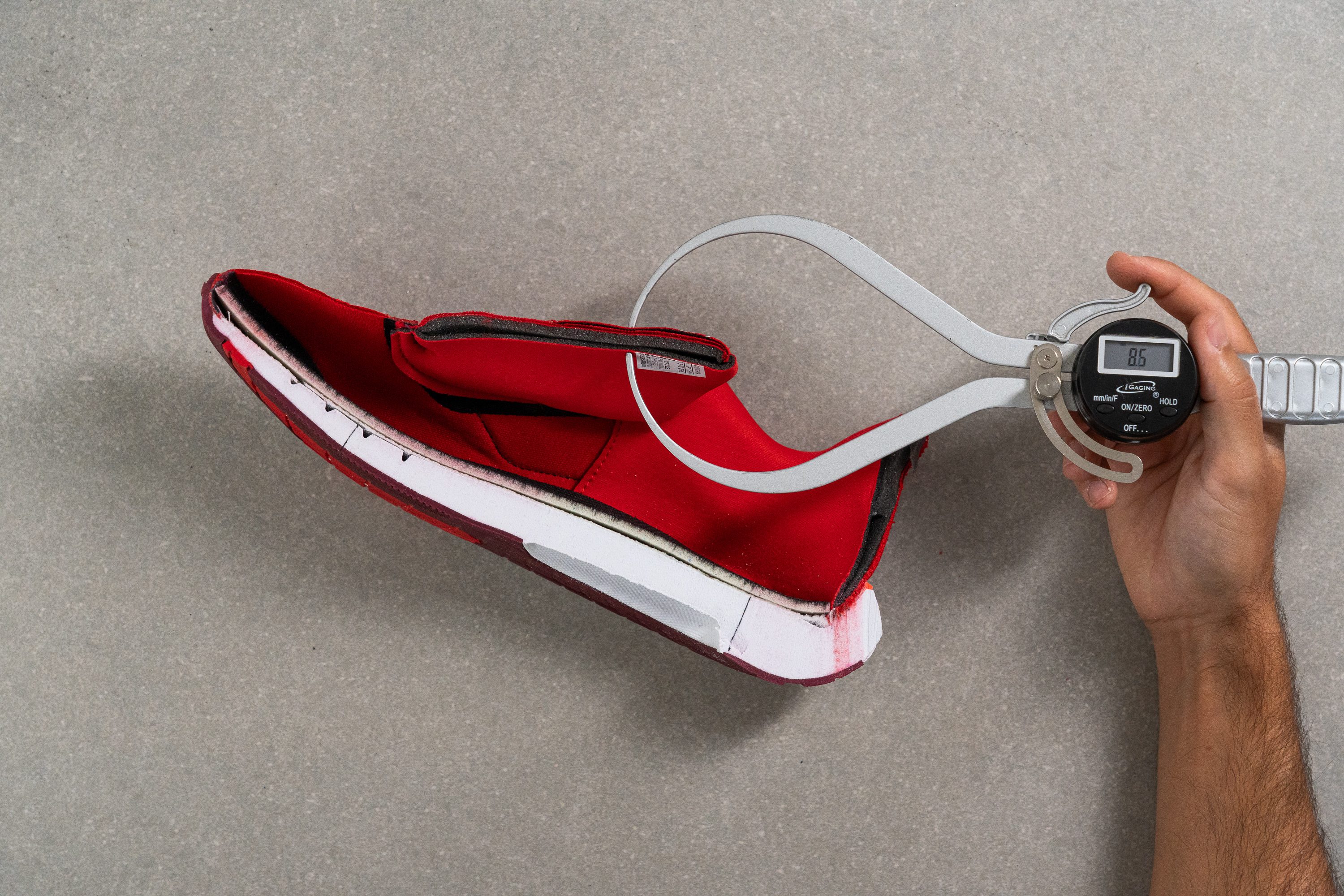
| Ultrabounce | 8.5 mm |
| Average | 5.8 mm |
Tongue: gusset type
The Ultrabounce’s tongue in non-gusseted, however the combination of how well padded it is and its sheer width across our instep means that we didn’t face any issues with it slipping during our test runs.
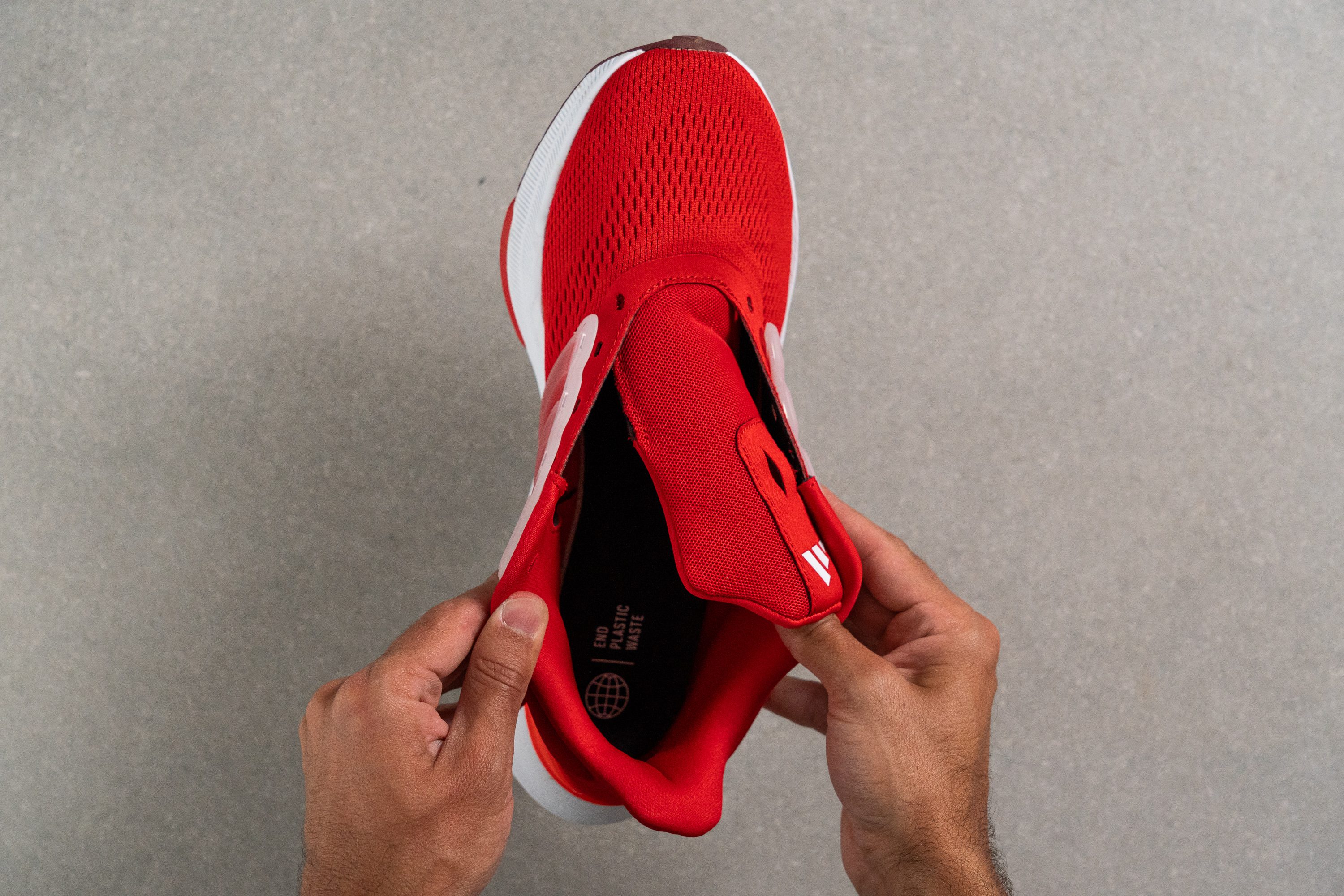
| Ultrabounce | None |
Heel tab
The Ultrabounce doesn’t have a traditional pull tab, but rather the heel itself flares upwards in a way that is easy to pull as we slide the shoes on.

| Ultrabounce | None |














































